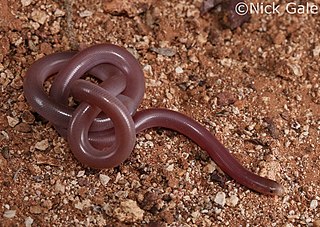
Gehyra is a genus of geckos in the family Gekkonidae. They are known as web-toed geckos or dtellas, and most species within the genus bear close resemblance to geckos from the genus Hemidactylus.

Diplodactylus is a genus of geckos of the family Diplodactylidae from Australia. They are sometimes called stone geckos or fat-tailed geckos. Member species are morphologically similar but genetically distinct.

Ctenophorus is a genus of lizards, commonly known as comb-bearing dragons, in the family Agamidae. The genus contains the most diverse group of dragon lizards in Australia. It is the largest group of Australian lizards and it has an extensive radiation in the arid zones. Many of the species of Ctenophorus have been grouped by a similar morphology. The informal names and groupings within this genus — rock dragon, crevice-dragon, ground-dragon, sand-dragon, and bicycle-dragon — are named after the mythological creature, the dragon.

Delma is a genus of lizards in the family Pygopodidae. The genus Delma contains 22 valid described species, all of which are endemic to Australia.

Carlia is a genus of skinks, commonly known as four-fingered skinks or rainbow skinks, in the subfamily Eugongylinae. Before being placed in this new subfamily, Carlia was recovered in a clade with the genera Niveoscincus, Lampropholis, and others of the Eugongylus group within Lygosominae.

Eremiascincus is a genus of skinks, lizards in the family Scincidae. The genus is endemic to Australia, Indonesia, and East Timor.

Crenadactylus, the clawless geckos, are named for their distinguishing feature, the absence of terminal claws on the digits. They are the only Australian members of Gekkonidae to lack claws, the endemic genus is also the smallest in size.
Anilios australis, or the southern blind snake, is a species of snake in the family Typhlopidae. The species is endemic to Australia.
Anilios broomi, also known commonly as Broom's blind snake, the faint-striped blind snake, and the striate blind snake, is a species of non-venomous snake in the family Typhlopidae. The species is endemic to Australia.
Anilios diversus, or the northern blind snake, is a species of snake in the family Typhlopidae. The species is endemic to Australia.

Anilios endoterus is commonly known as the interior blind snake. It is one of 42 species of snake in the genus Anilios (Ramphotyphlops) from the Typhlopidae family living in Australia. These snakes appear to be blind, having vestigial eyes that are extremely sensitive to light. It is a cryptic burrowing snake that lives in tunnels underground, living mainly on a diet of ants. They are found in arid and semi-arid desert regions of central Australia and are considered endangered in New South Wales (NSW).
The long-beaked blind snake is a species of snake in the family Typhlopidae, first described in 1918 by Edgar Waite as Typhlops grypus, and endemic to northern Australia.
The Top End blind snake is a species of snake in the family Typhlopidae. The species is endemic to Australia.
The Kimberley deep-soil blind snake is a species of snake in the family Typhlopidae. The species is endemic to Australia.
The buff-snouted blind snake is a species of snake in the family Typhlopidae. The species is endemic to Australia.
Anilios silvia, also known commonly as the great sandy blind snake or Sylvia's blind snake, is a species of snake in the family Typhlopidae. The species is endemic to northeastern Australia.
The beaked blind snake, also known commonly as Waite's blind snake, is a species of snake in the family Typhlopidae.
The brown-snouted blind snake, also known commonly as Wied's blind snake, is a species of snake in the family Typhlopidae. The species is endemic to Australia.
The Kimberley death adder is a species of venomous snake in the family Elapidae native to northwestern Australia.
Anilios ganei, also known commonly as Gane's blind snake, is a species of snake in the family Typhlopidae. The species is endemic to Australia.








